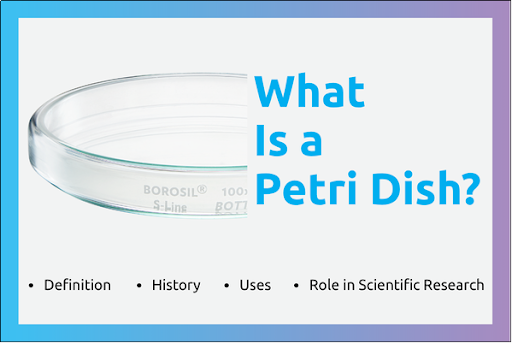



A Petri dish is a familiar sight in laboratories. It’s a shallow, round dish with a fitted lid used in microbiological research. The first Petri dish came about in the 1880s. Julius Richard Petri, who worked with Robert Koch, created it to simplify how we grow and watch microbes. Before that, scientists had to work with methods where contamination was a major issue. The invention of the Petri dish changed the story.
Petri dishes aid in observing microbial growth, testing new drugs, culturing microorganisms, and studying the effects of various environmental conditions on them, among other applications. The standard Petri dish is often glass or plastic. Glass ones can be cleaned and reused, while plastic ones are usually single-use. It has a clear, circular base and a cover that fits well enough to keep outside contaminants away. Mostly, Petri dishes are round; however, based on the requirement, you may find square and rectangular-shaped Petri dishes too.
Scientists need precision and control when culturing bacteria and fungi, and the Petri dish provides both. Its transparent design allows clear observation, while the flat surface of nutrient agar ensures even growth for consistent results. The fitted lid helps minimise contamination, making it an essential tool in microbiology.
Plus, you can store Petri dishes in neat stacks. They don’t take up much bench space. Some labs even put them into automated systems for mass testing. The dish’s design fits well with robotic arms and conveyor belts used in high-throughput environments. In biotech and pharma, their shape and material ensure seamless integration into automated workflows.
Not all Petri dishes are the same. Each type serves a unique purpose:
Proper handling of a Petri dish is crucial for reliable, contamination-free results. Let us discuss it in detail.
Before every usage, glass Petri dishes must be autoclaved. This procedure eliminates any residual microbes from earlier tests.
It’s time to prepare your nutrient agar after you have your sterile dish. Agar is a nutrient-rich gel-like medium that supports the growth of microorganisms. Carefully pour the agar solution into the plate after heating it in a flask until it melts. Allow it to cool until it solidifies. Make sure the surface is smooth because bubbles or uneven areas may impede microbial colony growth.
Next, introduce your sample. For bacteria, you might use a sterile loop or swab to transfer the cells onto the agar. Some people streak the sample in a pattern to isolate individual colonies. Others just spread it evenly if they want a lawn of growth.
Once you’re done, put the lid on and label the dish with the date and name of the microorganism.
Incubation is another key step. Flip the dish upside down, then place it in an incubator at the right temperature. Upside-down storage reduces water droplets falling onto the agar. Keep an eye on it for a day or two, or longer, depending on how fast your microbes grow. When you’re finished, the Petri dishes are autoclaved for cleaning.
A Petri dish serves as a fundamental tool in microbiology. Its primary function is culturing microorganisms, providing a controlled environment for bacterial and fungal growth. If you think about it, every step in microbiology, like identifying pathogens or testing new antibiotics, starts with culturing the microbes in a secure environment. That environment often ends up being a Petri dish lined with nutrient agar.
Petri dishes are used in the Kirby-Bauer antibiotic testing, also known as disc diffusion testing. Antibiotic discs are placed on a newly inoculated Petri dish. If the disc is responsive, a clear region around it will show where the antibiotic killed or stopped the bacteria. Doctors and pharmacists can use this test to identify the medication that could work best for treating an illness.
Beyond bacteria, Petri dishes support cell culture for plant and animal cells. Researchers might tweak the agar or use special coatings that help cells attach and multiply. Such cultures are often used in biotech labs to check the effect of specific compounds on cell growth. The dish’s clear surface makes it easy to monitor changes with a microscope.
Food safety testing is another giant one. Labs take samples of all kinds of foods, beef, milk, and drinks, and plate them up to test for microbial contamination. A Petri dish is used in the process of detecting Salmonella or E. coli. At the same time, in environmental monitoring, Petri dishes are required in experiments to monitor water and air quality. Scientists trap airborne microbes on agar plates or filter water through a membrane and put it on an agar dish to observe whether anything suspicious grows.
In essence, the Petri dish remains an indispensable tool across microbiology, biotechnology, medicine, and environmental science, enabling precise research, diagnostics, and quality control.
A Petri dish cannot actually “measure” anything; however, it aids researchers in monitoring microbial development, antibiotic resistance, and pollution levels. Researchers analyse the size, shape, and number of bacterial colonies over time to draw qualitative and quantitative inferences.
A Petri dish cover acts as a protective barrier. It excludes airborne contaminants but still permits controlled airflow, which is necessary for microbial growth. Without it, your culture might be destroyed by unwanted microbes suspended in the air.
A Petri dish provides a sterile, controlled environment for culturing and studying microorganisms. Its transparency allows for easy observation of microbial growth and interactions. When made of glass, it can be sterilised and reused, ensuring sustainability in laboratory settings.
A Petri plate is the simplest method for cultivating and monitoring microorganisms in a small area. Scientists use Petri dishes to create culture plates to examine bacteria, fungi, and even plant cells in a lab setting where all variables can be controlled.
Despite its broad definition, the term “Petri dish test” refers to any laboratory experiment involving microbial cultures. This could include tests for general bacterial proliferation, antibiotic sensitivity, or contamination in controlled conditions.